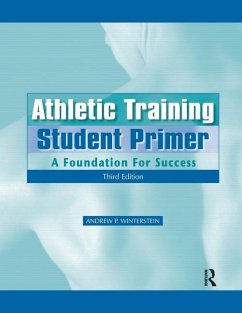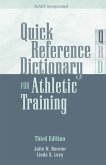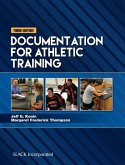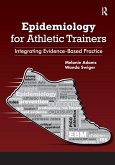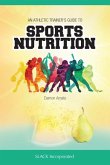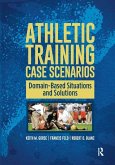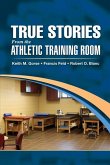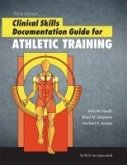- Broschiertes Buch
- Merkliste
- Auf die Merkliste
- Bewerten Bewerten
- Teilen
- Produkt teilen
- Produkterinnerung
- Produkterinnerung
Athletic Training Student Primer: A Foundation for Success, Third Edition is a dynamic text that provides students with a foundation upon which they can build their athletic training knowledge and develop an authentic understanding of the rewards and challenges of the athletic training profession.
Andere Kunden interessierten sich auch für
![Quick Reference Dictionary for Athletic Training Quick Reference Dictionary for Athletic Training]() Julie N. BernierQuick Reference Dictionary for Athletic Training77,99 €
Julie N. BernierQuick Reference Dictionary for Athletic Training77,99 €![Documentation for Athletic Training Documentation for Athletic Training]() Jeff G. KoninDocumentation for Athletic Training98,99 €
Jeff G. KoninDocumentation for Athletic Training98,99 €![Epidemiology for Athletic Trainers Epidemiology for Athletic Trainers]() Melanie AdamsEpidemiology for Athletic Trainers92,99 €
Melanie AdamsEpidemiology for Athletic Trainers92,99 €![An Athletic Trainers' Guide to Sports Nutrition An Athletic Trainers' Guide to Sports Nutrition]() Damon AmatoAn Athletic Trainers' Guide to Sports Nutrition81,99 €
Damon AmatoAn Athletic Trainers' Guide to Sports Nutrition81,99 €![Athletic Training Case Scenarios Athletic Training Case Scenarios]() Keith GorseAthletic Training Case Scenarios86,99 €
Keith GorseAthletic Training Case Scenarios86,99 €![True Stories From the Athletic Training Room True Stories From the Athletic Training Room]() Keith GorseTrue Stories From the Athletic Training Room76,99 €
Keith GorseTrue Stories From the Athletic Training Room76,99 €![Clinical Skills Documentation Guide for Athletic Training Clinical Skills Documentation Guide for Athletic Training]() John HauthClinical Skills Documentation Guide for Athletic Training103,99 €
John HauthClinical Skills Documentation Guide for Athletic Training103,99 €-
-
-
Athletic Training Student Primer: A Foundation for Success, Third Edition is a dynamic text that provides students with a foundation upon which they can build their athletic training knowledge and develop an authentic understanding of the rewards and challenges of the athletic training profession.
Hinweis: Dieser Artikel kann nur an eine deutsche Lieferadresse ausgeliefert werden.
Hinweis: Dieser Artikel kann nur an eine deutsche Lieferadresse ausgeliefert werden.
Produktdetails
- Produktdetails
- Verlag: Routledge
- 3. Auflage
- Seitenzahl: 408
- Erscheinungstermin: 15. Januar 2018
- Englisch
- Abmessung: 280mm x 216mm x 22mm
- Gewicht: 1022g
- ISBN-13: 9781617110924
- ISBN-10: 1617110922
- Artikelnr.: 54713966
- Herstellerkennzeichnung
- Libri GmbH
- Europaallee 1
- 36244 Bad Hersfeld
- gpsr@libri.de
- Verlag: Routledge
- 3. Auflage
- Seitenzahl: 408
- Erscheinungstermin: 15. Januar 2018
- Englisch
- Abmessung: 280mm x 216mm x 22mm
- Gewicht: 1022g
- ISBN-13: 9781617110924
- ISBN-10: 1617110922
- Artikelnr.: 54713966
- Herstellerkennzeichnung
- Libri GmbH
- Europaallee 1
- 36244 Bad Hersfeld
- gpsr@libri.de
Andrew P. Winterstein, PhD, ATC is a distinguished clinical professor in the Department of Kinesiology at the University of Wisconsin-Madison where he currently serves as the program director of the athletic training professional preparation program. A graduate of the University of Arizona, University of Oregon, and UW-Madison, Dr. Winterstein has been active in athletic training patient care and educational programming at UW-Madison since 1986. Dr. Winterstein's academic interests include: emerging technologies and their use in teaching and learning, medical humanities and their application to athletic training education, organizational dynamics, educational interventions/behavioral change, and patient-reported outcome measures following injury. His papers and abstracts have appeared in a variety of athletic training and sports medicine journals, and he has been privileged to make numerous professional presentations at state, regional, national, and international conferences. In addition to this text, he is the coauthor of Administrative Topics in Athletic Training: Concepts to Practice, Second Edition with Gary Harrelson and Greg Gardner and coauthor of The Athletic Trainers Guide to Differential Diagnosis: A Visual Learning Approach with Sharon Clark. Dr. Winterstein has received numerous awards, including the 2017 Sayers "Bud" Miller Distinguished Educator Award, 2016 National Athletic Trainers' Association (NATA) Most Distinguished Athletic Trainer Award, 2008 Great Lakes Athletic Training Association Outstanding Educator Award, 2007 Wisconsin Athletic Trainers' Association Outstanding Educator Award, and the 2006 UW-Madison School of Education Distinguished Service Award. He and his colleagues are 3-time winners of the NATA Educational Multimedia Committee award for educational innovations and have been awarded the MERLOT Classics Award for exemplary online learning objects. Andy enjoys fly fishing, standup paddling, watch collecting, reading, and writing. He resides in Madison, Wisconsin with his wife, Barb.
Dedication Photo and Illustration Credits Acknowledgments About the Author
Interview Participants and Contributors Foreword by Jay Hertel, PhD, ATC,
FNATA Preface Section I Understanding Athletic Training Chapter 1 Athletic
Training: An Allied Health Profession Chapter 2 Historical Perspectives and
Future Directions Chapter 3 Getting Started: Educational Requirements for
Athletic Training Chapter 4 Educational Resources for Athletic Training
Students Section II Common Injuries and Conditions Chapter 5 Understanding
Athletic Injury/Illness: Terminology and Classification Chapter 6 Common
Injuries to the Lower Extremity Chapter 7 Common Injuries to the Upper
Extremity Chapter 8 Common Injuries to the Head, Face, and Spine Chapter 9
Common Injuries to the Abdomen and Thorax, and General Medical Conditions
Section III Planning, Prevention, and Care Chapter 10 Blood-Borne Pathogens
and Standard Precautions Chapter 11 Emergency Planning and Injury
Evaluation Chapter 12 Environmental Concerns Chapter 13 First Aid and
Initial Injury Care Chapter 14 Components of Rehabilitation Chapter 15
Taping and Bracing Section IV Preparing for Success Chapter 16 Looking
Ahead Appendix A Board of Certification Standards of Professional Practice
Appendix B Athletic Training Manifesto Appendix C The Musculoskeletal
System Appendix D Sport Concussion Assessment Tool-5th Edition (SCAT5)
Appendix E Sample History and Pre- Participation Physical Examination Forms
Appendix F Résumé Action Words Index
Interview Participants and Contributors Foreword by Jay Hertel, PhD, ATC,
FNATA Preface Section I Understanding Athletic Training Chapter 1 Athletic
Training: An Allied Health Profession Chapter 2 Historical Perspectives and
Future Directions Chapter 3 Getting Started: Educational Requirements for
Athletic Training Chapter 4 Educational Resources for Athletic Training
Students Section II Common Injuries and Conditions Chapter 5 Understanding
Athletic Injury/Illness: Terminology and Classification Chapter 6 Common
Injuries to the Lower Extremity Chapter 7 Common Injuries to the Upper
Extremity Chapter 8 Common Injuries to the Head, Face, and Spine Chapter 9
Common Injuries to the Abdomen and Thorax, and General Medical Conditions
Section III Planning, Prevention, and Care Chapter 10 Blood-Borne Pathogens
and Standard Precautions Chapter 11 Emergency Planning and Injury
Evaluation Chapter 12 Environmental Concerns Chapter 13 First Aid and
Initial Injury Care Chapter 14 Components of Rehabilitation Chapter 15
Taping and Bracing Section IV Preparing for Success Chapter 16 Looking
Ahead Appendix A Board of Certification Standards of Professional Practice
Appendix B Athletic Training Manifesto Appendix C The Musculoskeletal
System Appendix D Sport Concussion Assessment Tool-5th Edition (SCAT5)
Appendix E Sample History and Pre- Participation Physical Examination Forms
Appendix F Résumé Action Words Index
Dedication Photo and Illustration Credits Acknowledgments About the Author
Interview Participants and Contributors Foreword by Jay Hertel, PhD, ATC,
FNATA Preface Section I Understanding Athletic Training Chapter 1 Athletic
Training: An Allied Health Profession Chapter 2 Historical Perspectives and
Future Directions Chapter 3 Getting Started: Educational Requirements for
Athletic Training Chapter 4 Educational Resources for Athletic Training
Students Section II Common Injuries and Conditions Chapter 5 Understanding
Athletic Injury/Illness: Terminology and Classification Chapter 6 Common
Injuries to the Lower Extremity Chapter 7 Common Injuries to the Upper
Extremity Chapter 8 Common Injuries to the Head, Face, and Spine Chapter 9
Common Injuries to the Abdomen and Thorax, and General Medical Conditions
Section III Planning, Prevention, and Care Chapter 10 Blood-Borne Pathogens
and Standard Precautions Chapter 11 Emergency Planning and Injury
Evaluation Chapter 12 Environmental Concerns Chapter 13 First Aid and
Initial Injury Care Chapter 14 Components of Rehabilitation Chapter 15
Taping and Bracing Section IV Preparing for Success Chapter 16 Looking
Ahead Appendix A Board of Certification Standards of Professional Practice
Appendix B Athletic Training Manifesto Appendix C The Musculoskeletal
System Appendix D Sport Concussion Assessment Tool-5th Edition (SCAT5)
Appendix E Sample History and Pre- Participation Physical Examination Forms
Appendix F Résumé Action Words Index
Interview Participants and Contributors Foreword by Jay Hertel, PhD, ATC,
FNATA Preface Section I Understanding Athletic Training Chapter 1 Athletic
Training: An Allied Health Profession Chapter 2 Historical Perspectives and
Future Directions Chapter 3 Getting Started: Educational Requirements for
Athletic Training Chapter 4 Educational Resources for Athletic Training
Students Section II Common Injuries and Conditions Chapter 5 Understanding
Athletic Injury/Illness: Terminology and Classification Chapter 6 Common
Injuries to the Lower Extremity Chapter 7 Common Injuries to the Upper
Extremity Chapter 8 Common Injuries to the Head, Face, and Spine Chapter 9
Common Injuries to the Abdomen and Thorax, and General Medical Conditions
Section III Planning, Prevention, and Care Chapter 10 Blood-Borne Pathogens
and Standard Precautions Chapter 11 Emergency Planning and Injury
Evaluation Chapter 12 Environmental Concerns Chapter 13 First Aid and
Initial Injury Care Chapter 14 Components of Rehabilitation Chapter 15
Taping and Bracing Section IV Preparing for Success Chapter 16 Looking
Ahead Appendix A Board of Certification Standards of Professional Practice
Appendix B Athletic Training Manifesto Appendix C The Musculoskeletal
System Appendix D Sport Concussion Assessment Tool-5th Edition (SCAT5)
Appendix E Sample History and Pre- Participation Physical Examination Forms
Appendix F Résumé Action Words Index

